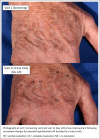A feasibility study of microwave therapy for precancerous actinic keratosis
- PMID: 32030723
- PMCID: PMC7496712
- DOI: 10.1111/bjd.18935
A feasibility study of microwave therapy for precancerous actinic keratosis
Abstract
Background: Actinic keratosis (AK) is a common premalignant skin lesion that can progress to cutaneous squamous cell carcinoma (cSCC). Microwave therapy is an established cancer treatment and has been used for plantar viral warts.
Objectives: To evaluate the efficacy and feasibility of microwave as a treatment for AK.
Methods: Stage I was a dose-setting study, in which seven participants had the dielectric properties of 12 thick and 22 thin AKs assessed for optimization of the microwave dose used for treatment in Stage II. Stage II was a randomized, internally controlled trial evaluating 179 AKs in 11 patients (93 treated, 86 untreated controls) on the scalp/forehead or dorsal hand. Participants received one treatment initially and a repeat treatment to unresolved AKs at week 4. The response was assessed at six visits over 4 months. The primary outcome was partial or complete resolution of the treated AKs.
Results: A significantly higher proportion of treated AK areas responded than untreated (90% vs. 15%; P < 0·001). Thin AKs were more responsive than thick AKs. The site did not affect efficacy. Pain was severe, but brief (80% reported pain lasting 'a few seconds only'). Adverse effects were minimal (erythema, n = 6; flaking, n = 3; itch, n = 3). All participants who would chose microwave therapy over their current treatment cited the shorter discomfort period.
Conclusions: Microwave therapy is a portable, safe and effective treatment for AK. An easy-to-deliver, acceptable therapy for AK is attractive as a prevention strategy. While these results are promising, a larger randomized controlled trial is needed against an effective comparator to confirm clinical efficacy and patient acceptability. What is already known about this topic? Actinic keratoses (AKs) are common precancerous skin lesions. Successful treatment of AK can prevent cutaneous squamous cell carcinoma (cSCC). Most topical therapies for AK require repeated application over weeks and drive local skin inflammation, leading to poor compliance. An easy-to-deliver and effective treatment for AK, suitable for use in primary care, could reduce cSCC. What does this study add? Microwave therapy is a feasible, effective treatment for AK. Ninety per cent of treated AKs showed full or partial resolution at 120 days post-treatment. Microwave therapy was painful, but the pain was short-lived (seconds) and this short discomfort period was cited as the main reason that microwave was preferred to their current treatment.
© 2020 The Authors. British Journal of Dermatology published by John Wiley & Sons Ltd on behalf of British Association of Dermatologists.
Figures




Comment in
-
Innovative devices for actinic keratoses: a hot-button issue.Br J Dermatol. 2020 Aug;183(2):197-199. doi: 10.1111/bjd.19249. Epub 2020 Jun 21. Br J Dermatol. 2020. PMID: 32567062 No abstract available.
-
Actinic keratoses: pain severity after cryotherapy and patient tolerability of treatment.Br J Dermatol. 2021 Jul;185(1):234-235. doi: 10.1111/bjd.19869. Epub 2021 Apr 1. Br J Dermatol. 2021. PMID: 33544880 No abstract available.
References
-
- Flohil SC, van der Leest RJT, Dowlatshahi EA et al Prevalence of actinic keratosis and its risk factors in the general population: The Rotterdam Study. J Invest Dermatol 2013; 133:1971–8. - PubMed
-
- Goon PK, Greenberg DC, Igali L, Levell NJ. Squamous cell carcinoma of the skin has more than doubled over the last decade in the UK. Acta Derm Venereol 2016; 96:820–1. - PubMed
-
- Marks R, Rennie G, Selwood TS. Malignant transformation of solar keratoses to squamous cell carcinoma. Lancet 1988; 1:795–7. - PubMed
-
- Criscione VD, Weinstock MA, Naylor MF et al Actinic keratoses: natural history and risk of malignant transformation in the Veterans Affairs Topical Tretinoin Chemoprevention Trial. Cancer 2009; 115:2523–30. - PubMed
Publication types
MeSH terms
Grants and funding
LinkOut - more resources
Full Text Sources
Medical
Research Materials

